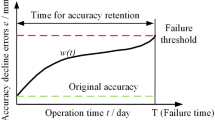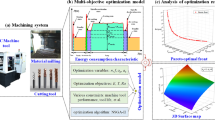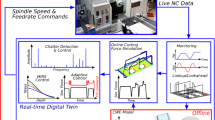Abstract
The complex surface machining quality is related to the capacity of the control system, servo drive and mechanical transmission in five-axis CNC machining. The unsuitable parameters result in surface contour errors and other processing abnormal phenomena such as tool marks and corrugated surface. In this paper a twisted ruled surface in flank milling is analyzed. The construction features of surface and the tool path characteristic of the specimen are listed. The surface cutting velocity is deduced considering the constraints of the acceleration, jerk and other control parameters and the smoothness is modeled. The individual tracking error acquired from servo feed system model is converted to the contour error by homogeneous transformation matrix and Frenet frame, and abnormal tool marks in flank milling are suggested. The cutting experiments conform to simulation; the effect of the dynamic indicators of the CNC machine tool is explored by the abnormal marks on the machined parts. This approach provides a support for designing specimens and investigating machine tool dynamics performance in working accuracy test.
Similar content being viewed by others
References
B. Sencer and Y. Altintas, Modeling and control of contouring errors for five-axis machine tools-Part II: Precision contour controller design, Journal of Manufacturing Science and Engineering, 131 (3) (2009) 1–10.
O. R. Tutunea-Fatan and H. Y. Feng, Determination of geometry- based errors for interpolated tool paths in five-axis surface machining, Journal of Manufacturing Science and Engineering, 127 (1) (2005) 60–67.
M. J. B. Fard and H. Y. Feng, Effect of tool tilt angle on machining strip width in five-axis flat-end milling of freeform surfaces, International Journal of Advanced Manufacturing Technology, 44 (3–4) (2009) 211–222.
M. Munlin, S. S. Makhanov and E. L. Bohez, Optimization of rotations of a five-axis milling machine near stationary points, Computer-Aided Design, 36 (12) (2004)1117–28.
K. Erkorkmaz and Y. Altintas, Precision tracking controller design for high speed feed drives, Proc. of ASME 2005 International Mechanical Engineering Congress and Exposition, Orlando, Florida, USA (2005) 657–668.
W. H. Zhao et al., New evaluation method on the precision of NC machine tools, Engineering Science, 15 (1) (2013) 93–98.
B. Sencer, Y. Altintas and E. Croft, Modeling and control of contouring errors for five-axis machine tools-Part I: Modeling, Journal of Manufacturing Science and Engineering, 131 (3) (2009) 1–8.
K. Erkorkmaz and Y. Altintas, Quintic spline interpolation with minimal feed fluctuation, Journal of Manufacturing Science and Engineering, 127 (2) (2005) 339–349.
F. C. Wang and D. Yang, Nearly arc-length parameterized quintic-spline interpolation for precision machining, Computer Aided Design, 25 (5) (1993) 281–288.
Z. Y. Song and Y. W. Cui, S-shape detection test piece and a detection method for detection the precision of the numerical control milling machine, In: US20100004777, USA (2010).
Standards N.A. NAS 979, Uniform Cutting Tests, NAS 900 Series metal cutting equipment specifications, USA (1969).
T. L. Schmitz et al., Case study: A comparison of error sources in high-speed milling, Precision Engineering, 32 (2) (2008) 126–133.
W. J. Jeon, Efficient acceleration and deceleration technique for short distance movement in industrial robots and CNC machine tools, Electronics Letters, 36 (8) (2000) 765–772.
T. K. Naskar and R. Mishra, Introduction of control points in B-splines for synthesis of ping finite optimized cam motion program, Journal of Mechanical Science and Technology, 26 (2) (2012) 489–494.
T. Yamazaki et al., Development of a high-performance spindle for multitasking machine tools, International Journal of Automation Technology, 3 (4) (2009) 378–384.
K. Erkorkmaz and Y. Altintas, High speed CNC system design. Part I jerk limited trajectory generation and quintic spline interpolation, International Journal of Machine Tools and Manufacture, 41 (9) (2001) 1323–1345.
J. H. Chen, An S-curve acceleration/deceleration design for CNC machine tools using quintic feedrate functions, Computer Aided Design and Applications, 8 (4) (2011) 583–92.
R. Ramesh et al., Tracking and contour error control in CNC servo systems, Journal of Manufacturing Science and Engineering, 45 (3) (2005) 301–326.
R. SATO and M. TSUTSUMI, Modeling and controller tuning techniques for feed drive systems, Proc. of ASME 2005 International Mechanical Engineering Congress and Exposition, Orlando, Florida, USA (2005) 669–679.
R. S. Lin and T. H. Lin, Trajectory analyses for five-axis machine tools. Proc. of Robotics, Automation and Mechatronics, Singapore, Singapore (2010) 136–141.
M. S. Uddin et al., Prediction and compensation of machining geometric errors of five-axis machining centers with kinematic errors, Precision Engineering, 33 (2) (2009) 194–201.
S. H. Nam and M. Y. Yang, A study on a generalized parametric interpolator with real-time jerk-limited acceleration, Computer Aided Design, 36 (1) (2004) 27–36.
Y. Jung et al., NC post-processor for 5-axis milling machine of table-rotating/tilting type, Journal of Materials Processing Technology, 130 (2002) 641–646.
Author information
Authors and Affiliations
Corresponding author
Additional information
Recommended by Associate Editor Jun-Ho Jeong
Dong Xie received the B.S. degree from University of Electronic Science and Technology of China and M.S. degree from Yanshan University. Now he is a Ph.D. candidate in the School of Mechatronics Engineering, University of Electronic Science and Technology of China. His research interest is accuracy testing for CNC machine tool.
Jie-xiong DING received the B.S. degree in Mechanical Engineering from the University of Electronic Science and Technology of China (UESTC) and received the M.S. degree in Mechatronics from UESTC. He is a professor, doctoral tutor in School of Mechatronics Engineering of UESTC. His research interests include mechatronics and precision engineering.
Rights and permissions
About this article
Cite this article
Xie, D., Ding, J., Liu, F. et al. Modeling errors forming abnormal tool marks on a twisted ruled surface in flank milling of the five-axis CNC. J Mech Sci Technol 28, 4717–4726 (2014). https://doi.org/10.1007/s12206-014-0151-0
Received:
Revised:
Accepted:
Published:
Issue Date:
DOI: https://doi.org/10.1007/s12206-014-0151-0




